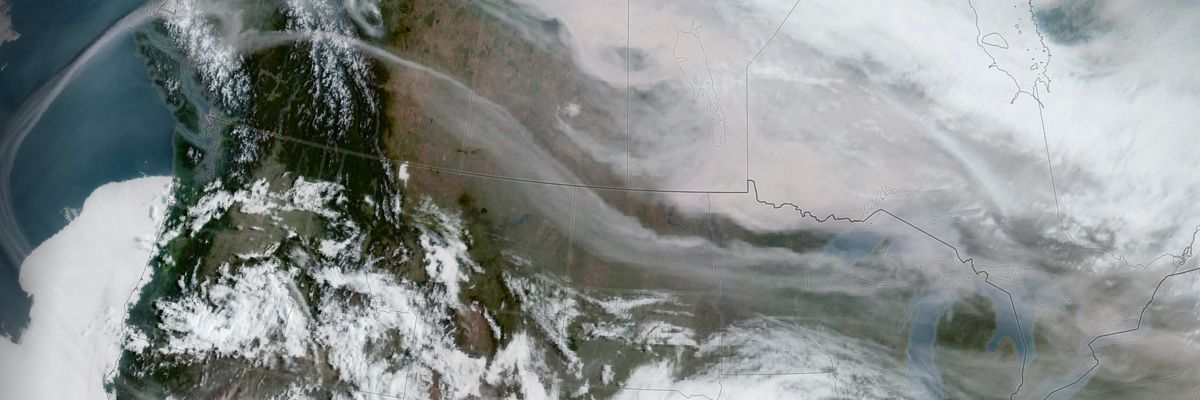Ask anyone on the East Coast of Canada or the U.S. recently about their air quality, and they will tell you the same story.
They will say that the acrid choking air from Canada’s wildfires has made their lives miserable over the last few weeks, with
residents experiencing the worse air quality in years.
Whereas air quality in the U.S. has improved, Canadians continue to suffer. The smoke from the forest fires left Montreal blanketed with smog this last weekend,
giving it the worst air quality of any major city in the world.
So far across the country, some 7.7 million hectares of forest have caught fire, with 259 current fires burning out of control. Although we are only still in June, this surpasses Canada’s worst previous fire year in 1995, when 7.1 million hectares were burnt.
The amount of forest burnt in Canada’s worst fire season is vast. Usually, wildfires predominantly occur in the West. But this year, they have burned across Canada, with some of the worst fires in the East. Quebec, for example, has seen over a million hectares burnt.
So far across the country, some
7.7 million hectares of forest have caught fire, with 259 current fires burning out of control. Although we are only still in June, this surpasses Canada’s worst previous fire year in 1995, when 7.1 million hectares were burnt.
And the problem for Canada and the U.S. is that the worst is yet to come. We have yet to reach peak fire season.
The fires have already had a catastrophic impact.
Earlier this month, the air quality was so bad that New York’s famous skyline turned a hazy orange, and school-children were told to stay indoors.
The smoke added another angle of climate change-induced impacts hitting the U.S. population hard, with some
50 million people currently exposed to extreme heat across the country as large parts melt under a heat dome.
According to scientists, climate change has made the record heat five times more likely. And now a
new report from the Center for American Progress estimates that the extreme heat will cause $1 billion in healthcare-related costs in the U.S. this year alone, leading to 235,000 emergency department visits and over 56,000 hospital admissions. While everyone is feeling the consequences of extreme heat and toxic air, children, older people, outdoor workers, and low-income communities are experiencing the worst outcomes.
And the smoke is not just impacting the U.S. and Canada.
It has been moving across the Atlantic, finally reaching Portugal and Spain yesterday.
The Canadian fires also have other impacts too. These fires have brought to light yet another reason why attempts by fossil fuel companies to “carbon offset” do not work. An investigation by
Bloomberg Green has found that some of the millions of tons of carbon dioxide pumped into the atmosphere from the fires have come from a “carbon offset project.”
Bloomberg notes that this highlights the “fragility of a tool the world relies on to fight catastrophic climate change.”
Earlier this month, officials from British Columbia spotted a blaze that had impacted the BigCoast Forest Climate Initiative offset project.
Bloomberg Green was told that “About 100 hectares of our 40,000-hectare project was involved in this fire,” or about 0.25% of the project.
Although this number may sound small, Werner Kurz, a senior research scientist in the Canadian Forest Service, told
Bloomberg Green that the fire could have emitted up to 32,250 tons of carbon dioxide equivalent. He called it “clearly not trivial.”
Bloomberg highlights the potential flaw in the system here because fires are not seen as a risk to the trees.
The logging company behind the impacted forest, Mosaic, has committed to not cutting trees down for 30 years and is selling the additional carbon stored as offsets under the rules of the official registry company Verra.
Bloomberg highlights the potential flaw in the system here because fires are not seen as a risk to the trees. This means there is a possibility that a company sells an offset, based on locking-in carbon for decades, only for that tree to catch fire much sooner and release the carbon.
This adds further weight to how flawed offsets are.
Earlier this year, a
Guardian and Source Material investigation found that more than 90% of rainforest carbon offsets issued by Verra were effectively “worthless” or “phantom credits,” which do not meaningfully reduce carbon.
At the time, Barbara Haya, the director of the Berkeley Carbon Trading Project, who has been researching carbon credits for 20 years, said: “Companies are using credits to make claims of reducing emissions when most of these credits don’t represent emissions reductions at all.”
As our earth warms, wildfires across the globe are on the increase. This means that forests are under threat like never before. The more we rely on forests to offset the dirty oil industry’s activities, the more problems there could be. The Canadian wildfires have given us yet another reason to be wary of carbon offsetting.

